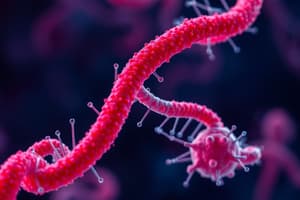Podcast
Questions and Answers
According to the phase plane diagram, what is the approximate value of the carrying capacity (K) for species 1?
According to the phase plane diagram, what is the approximate value of the carrying capacity (K) for species 1?
- $K_1 = 25$
- $K_1 = 50$ (correct)
- $K_1 = 60$
- $K_1 = 43$
Based on the information provided, which statement best describes the coexistence of the two species?
Based on the information provided, which statement best describes the coexistence of the two species?
- The species can coexist, but one species will eventually outcompete the other.
- The species cannot coexist because their isoclines do not intersect.
- The species cannot coexist because their carrying capacities are different.
- The species can coexist, and their populations will stabilize at the point where the isoclines intersect. (correct)
What is the approximate value of the population size for species 2 at the point where the isoclines intersect?
What is the approximate value of the population size for species 2 at the point where the isoclines intersect?
- $N_2 \approx 60$
- $N_2 \approx 50$
- $N_2 \approx 25$
- $N_2 \approx 43$ (correct)
Which of the following statements best describes the trajectory of the population dynamics shown in the time series plot?
Which of the following statements best describes the trajectory of the population dynamics shown in the time series plot?
Which of the following statements is true about the stability of the ecosystem represented by the phase plane diagram?
Which of the following statements is true about the stability of the ecosystem represented by the phase plane diagram?
Based on the phase plane diagram, which of the following statements is true about the competitive relationship between the two species?
Based on the phase plane diagram, which of the following statements is true about the competitive relationship between the two species?
In a competitive scenario between two species, what does it mean when the isoclines intersect at a point on the phase plane?
In a competitive scenario between two species, what does it mean when the isoclines intersect at a point on the phase plane?
According to the Lotka-Volterra competition equations, which of the following outcomes is NOT possible for two competing species?
According to the Lotka-Volterra competition equations, which of the following outcomes is NOT possible for two competing species?
If the isocline for species A is a horizontal line on the phase plane, what does this imply about the growth rate of species A?
If the isocline for species A is a horizontal line on the phase plane, what does this imply about the growth rate of species A?
In a competitive scenario where the isoclines do not intersect on the phase plane, what can be concluded about the outcome?
In a competitive scenario where the isoclines do not intersect on the phase plane, what can be concluded about the outcome?
What is the significance of the slope of an isocline on the phase plane?
What is the significance of the slope of an isocline on the phase plane?
In a competitive scenario with two species, what does it mean if the isoclines are parallel and do not intersect?
In a competitive scenario with two species, what does it mean if the isoclines are parallel and do not intersect?
According to the information provided, what condition must be met for stable coexistence of two competing species?
According to the information provided, what condition must be met for stable coexistence of two competing species?
Which of the following statements best describes the criterion for coexistence of competitors, as shown in the equations?
Which of the following statements best describes the criterion for coexistence of competitors, as shown in the equations?
In the phase plane diagram, what do the regions with K's on the inside and outside represent?
In the phase plane diagram, what do the regions with K's on the inside and outside represent?
Based on the phase plane diagram and the trajectory shown, what can be inferred about the coexistence of the two species?
Based on the phase plane diagram and the trajectory shown, what can be inferred about the coexistence of the two species?
In the phase plane diagram, what do the isoclines represent?
In the phase plane diagram, what do the isoclines represent?
According to the information provided, what condition must be met for similar species to coexist?
According to the information provided, what condition must be met for similar species to coexist?
Flashcards are hidden until you start studying




